The meander was a common ornament in antique Greece in many variations and different patterns. In the Antiquities Collection of the Martin von Wagner Museum of the University of Würzburg I have found many different examples. Some information to the different types of meanders I found in the basic work from Robert Manuel Cook “Clazomenian Sarcophagi”, published by Philip von Zabern in 1981, Mainz.
Here a small collection, completed with some photos.
The simplest forms have not yet closed lines, they are called broken or hook meanders. For the archeologists they count to the meanders and not to the spirals. These are always angular shaped lines. Substantially for a “true” meander is the change of direction. The line turns first inwards and then outwardly. As it is in a labyrinth. Hence, the movement pattern shows the relationship between labyrinth and meander. The meander must have a specific pattern if I want to develop a labyrinth from it.
A clue is the number of the horizontal bars in a meander. “Labyrinth-suitable” must have four or more, but always an even number of lines. In addition the lines must kink the right way.
Figure 15 shows the basic type of a “true” meander with four horizontal bars.
The goddess’s picture from the time about 550 BC is decorated with a broken meander (as illustrated in figure 3).
The amphora from the time about 470 BC is surrounded by a row of broken meanders (as illustrated in figure 4). The main pictures show goddesses with quadrigas, the shoulder pictures the battle of Troy.
From the type of meander, illustrated in figure 8, with eight horizontal bars the classical 7 circuit labyrinth with two turning points can be generated.
The types of meanders, illustrated in the figures 9 to 13, are defined as false meanders because they only turn in one direction.
This chalice from Chios from the time about 600 BC has to offer beside the hook meanders (as illustrated in figure 1) also some false meanders.
In this vase painting with the representation of a tragedy choir from the time about 400 BC a broken meander with eight horizontal bars, which corresponds to the type illustrated in figure 8 is to be recognised in the middle of the lower row. Left of it is the “overtwisted” meander as illustrated in figure 18.
Till now I have not (yet) discovered a closed meander with eight horizontal bars in the Martin von Wagner Museum.
The types illustrated from figure 14 on are closed meanders. The type from figure 15 is the closed form from figure 4.
The geometrical grave urn from the time about 750 BC shows a row of meanders as illustrated in figure 14.
The types illustrated in the figures 17a and 17b show the closed form of the types illustrated in the figures 7a and 7b with six horizontal bars, suitable for a 5 circuit classical labyrinth.
The type illustrated in figure 18 has one twisting too much and nine horizontal bars and, hence, is not suitable to produce a labyrinth.
The chalice from Chios from the time about 600 BC shows beside the hook meander and the false meander also a row of “true” meanders with six horizontal bars as illustrated in figure 17b.
The types of meanders illustrated in the figures 19 to 21 are called meander crosses.
On this fragment of a Clazomenian sarcophagus from the time about 500 BC other cross meanders are to be found. The “circled” fields are mostly filled with different decorations.
The meander developed more and more complicated. The intertwined lines, though always angular shaped, probably pointed out some day a relationship to the labyrinth. In the Roman sector labyrinths the meander appeared finally as a design element. The labyrinth was not developed any more only from the basic pattern.
Related Posts

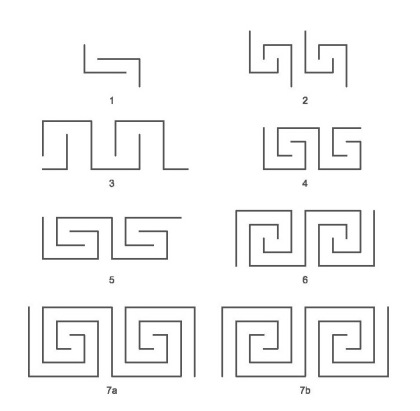
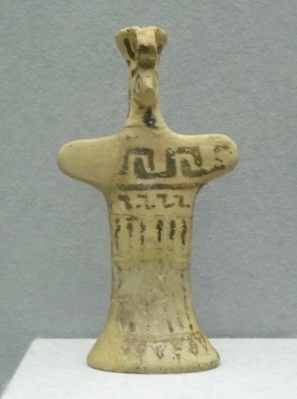

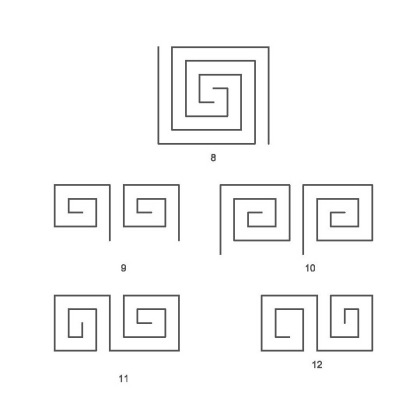
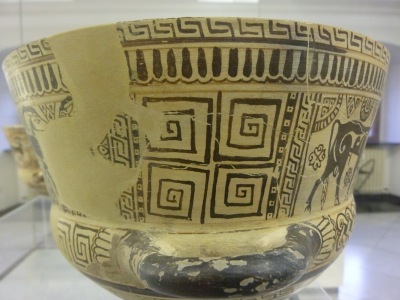
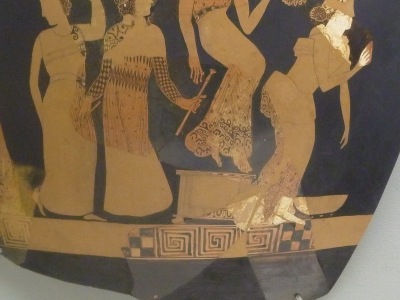



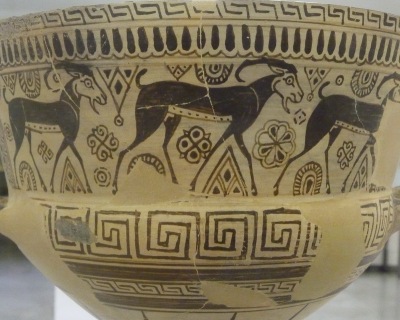


I do not think I had connected the geometric designs on Greek ceramics to the labyrinth before now – thanks to you I’ll look at them with wiser eyes now!
LikeLiked by 1 person
That’s what I want: To open our eyes to the development of the labyrinth geometry. Thanks for your reaction.
LikeLiked by 1 person
Pingback: Making a pot-shaped screen • Past Times History
Pingback: A Golden Greek 50 Euro Commemorative Coin from 2017 | blogmymaze
Pingback: In Search of the Meander at Berlin | blogmymaze
What an interesting and informative Blog again Erwin. Thank you for sharing, you learn us so much and the old designs on all these antque artifacts are a gem!
LikeLike
I really appreciate seeing the meander designs on these beautiful original pieces paired with the simple line drawings. It really helps in the contemplation of how these designs were used and had significance. I have accumulated meander patterns in my travels throughout Mexico. It would be interesting to explore if these designs predate Spanish contact. Thank you Erwin!
LikeLike
Beautiful Erwin. I really enjoy seeing pics of the originals and then the simple line drawings here. Paired together it really helps in the contemplation of the use of these designs. In my travels throughout Mexico, I’ve accumulated the different meanders that I’ve come across. It would be interesting to explore if these are pre-spanish contact. Thank you!
LikeLike